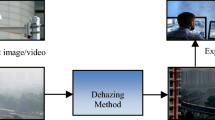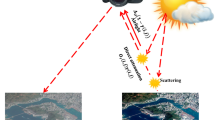Abstract
Image contrast enhancement for outdoor vision is important for smart car auxiliary transport systems. The video frames captured in poor weather conditions are often characterized by poor visibility. Most image dehazing algorithms consider to use a hard threshold assumptions or user input to estimate atmospheric light. However, the brightest pixels sometimes are objects such as car lights or streetlights, especially for smart car auxiliary transport systems. Simply using a hard threshold may cause a wrong estimation. In this paper, we propose a single optimized image dehazing method that estimates atmospheric light efficiently and removes haze through the estimation of a semi-globally adaptive filter. The enhanced images are characterized with little noise and good exposure in dark regions. The textures and edges of the processed images are also enhanced significantly.









Similar content being viewed by others
References
Ahlen J, Sundgren D, Bengtsson E (2007) Application of underwater hyperspectal data for color correction purposes. Pattern Recog Image Anal 17(1):170–173
C. Ancuti, C. O. Ancuti, T. Haber, P. Bekaert, “Enhancing underwater images and videos by fusion”, in Proc. of IEEE Conference on Computer Vision and Pattern Recognition, pp. 81–88, 2012.
F. Cozman, E. Krotkov, “Depth from scattering”, in Proc. of IEEE Conference on Computer Vision and Pattern Recognition, pp.801–806, 1997.
Fattal R (2008) Single image dehazing. ACM Trans Graph 27(3):1–8
Fattal R (2014) Dehazing using color-lines. ACM Trans Graph:1–10
Gibson KB, Vo DT, Nguyen TQ (2012) An investigation of dehazing effects on image and video coding. IEEE Trans Image Process 21(2):662–673
N. Hautiere, J.P. Tarel, D. Aubert, “Towards fog-free in-vehicle vision systems through contrast restoration”, in IEEE Conference on Computer Vision and Pattern Recognition, pp.1–8, 2008.
Hautiere N, Tarel J-P, Aubert D, Dumont E (2008) Blind contrast restoration assessment by gradient radioing at visible edges. In Proc Int Congr Stereology 27(2):87–95
He K, Sun J, Tang X (2011) Single image haze removal using dark channel prior. IEEE Trans Pattern Anal Mach Intell 33(12):2341–2353
Kim J, Jang W, Sim J, Kim C (2013) Optimized contrast enhancement for real-time image and video dehazing. J Vis Commun Image Representation 24:410–425
Koschmieder H (1925) Theorie der horizontalen sichtweite: kontrast und sichtweite. Keim Nemnich Press 2:1–11
Liang J, Ren L, Ju H, Qu E, Wang Y (2014) Visibility enhancement of haze images based on a universal polarimetric imaging method. J Appl Phys 116(17):1731071–1731077
Mantiuk R, Kim KJ, Rempel AG, Heidrich W (2011) HDR-VDP2: a calibrated visual metric for visibility and quality predictions in all luminance conditions. ACM Trans Graph 30(4):40–52
Narasimhan S, Nayar S (2003) Contrast restoration of weather degraded images. IEEE Trans Pattern Anal Mach Intell 25(6):713–724
Schechner Y, Karpel N (2005) Recovery of underwater visibility and structure by polarization analysis. IEEE J Ocean Eng 30(3):570–587
Schechner Y, Narasimhan S, Nayar S (2001) “Instant dehazing of images using polarization”, in: proc. of computer vision and. Pattern Recogn 1:325–332
Schettini R, Corchs S (2010) Underwater image processing: state of the art of restoration and image enhancement methods. EURASIP J Adv Signal Process 746052
Serikawa S, Lu H (2014) Underwater image dehazing using joint trilateral filter. Comput Electr Eng 40(1):41–50
R.T. Tan, “Visibility in bad weather from a single image”, in Proc. of IEEE Conference on Computer Vision and Pattern Recognition, pp.1–8, 2008.
J. Tarel, N. Hautiere, “Fast visibility restoration from a single color or gray level image”, in Proc. of the IEEE International Conference on Computer Vision, pp. 2201–2208, 2009.
Wang Z, Bovik AC, Sheikh HR, Simoncelli EP (2004) Image quality assessment: from error visibility to structural similarity. IEEE Trans Image Process 13(4):600–612
S. Yao, W. Lin, E. Ong, Z. Lu, “Contrast signal to noise ratio for image quality assessment”, in Proc. of International Conference on Image Processing, pp. 397–400, 2005.
Acknowledgments
All of the authors have the same contribution to this paper. This work was supported by Grant in Aid for Foreigner Research Fellows of Japan Society for the Promotion of Science (No.15F15077), Open Fund of the Key Laboratory of Marine Geology and Environment in Chinese Academy of Sciences (No.MGE2015KG02), Research Fund of State Key Laboratory of Marine Geology in Tongji University (MGK1407), Research Fund of State Key Laboratory of Ocean Engineering in Shanghai Jiaotong University (OEK1315), and Grant in Aid for Research Fellows of Japan Society for the Promotion of Science (No.13 J10713).
Author information
Authors and Affiliations
Corresponding author
Rights and permissions
About this article
Cite this article
Lu, H., Li, Y., Nakashima, S. et al. Single image dehazing through improved atmospheric light estimation. Multimed Tools Appl 75, 17081–17096 (2016). https://doi.org/10.1007/s11042-015-2977-7
Received:
Revised:
Accepted:
Published:
Issue Date:
DOI: https://doi.org/10.1007/s11042-015-2977-7




